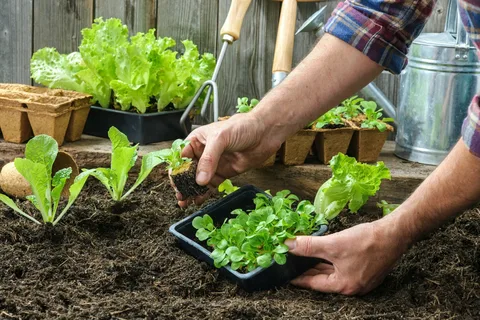Starting a vegetable garden at home is one of the most rewarding activities you can undertake. Not only do you get fresh, organic produce right at your fingertips, but gardening also promotes physical activity, mental wellness, and a deeper connection with nature.
Advertisement
This comprehensive beginner’s guide will walk you through everything you need to know to get started, from choosing the right location to harvesting your first crops.
1. Why Start a Vegetable Garden?
Growing your own vegetables has a host of benefits:
-
Healthier Food: You control what goes into your soil—no pesticides or chemicals if you don’t want them.
-
Cost Savings: Growing your own food can reduce grocery bills significantly.
-
Sustainability: Fewer trips to the store means less fuel usage and packaging waste.
-
Mental Health: Gardening reduces stress, increases mindfulness, and provides a sense of accomplishment.
Whether you have a big backyard or just a sunny balcony, you can grow something edible.
2. Choosing the Right Spot
Vegetables need three things to thrive: sunlight, good soil, and access to water.
-
Sunlight: Most vegetables need 6–8 hours of direct sunlight daily. Observe your space and track how the sun moves throughout the day.
-
Soil: Healthy soil is dark, crumbly, and rich in organic matter. You can improve poor soil with compost or consider raised beds with high-quality soil mix.
-
Water Access: Make sure your garden is near a hose or water source. Drip irrigation or soaker hoses are helpful for efficiency.
If ground space is limited, consider container gardening or vertical gardening on patios or balconies.
3. Deciding What to Grow
Start simple. Choose vegetables that:
-
Are easy to grow
-
Match your climate
-
You and your family actually eat
Here are excellent beginner-friendly vegetables:
| Vegetable | Season | Notes |
|---|---|---|
| Lettuce | Spring/Fall | Quick to grow, loves cool weather |
| Tomatoes | Summer | Needs full sun and support |
| Zucchini | Summer | Prolific producer |
| Carrots | Spring/Fall | Grows well in loose soil |
| Radishes | Spring/Fall | Harvest in 25–30 days |
| Green beans | Summer | Bush or pole varieties |
| Herbs (basil, mint, parsley) | Spring/Summer | Great for small spaces and containers |
Start with a handful of crops, and expand as your confidence grows.
4. Preparing Your Garden Bed
Once you’ve selected your crops and location, it’s time to prepare the bed.
-
Clear the Area: Remove grass, weeds, and rocks.
-
Loosen the Soil: Use a shovel or garden fork to turn the soil about 12 inches deep.
-
Add Compost: Enrich the soil with organic compost for nutrients and better drainage.
-
Form Rows or Raised Beds: Raised beds are easier to manage and great for beginners.
If you’re container gardening, choose pots with drainage holes and fill them with a mix of potting soil and compost.
5. Planting Tips
-
Follow Spacing Guidelines: Crowding plants can reduce yield and increase disease.
-
Check Seed Packets: They give details on planting depth, spacing, and sunlight needs.
-
Succession Planting: Plant new crops every 2–3 weeks to keep a steady harvest.
-
Companion Planting: Some plants grow better together (e.g., tomatoes and basil) while others don’t (e.g., onions and beans).
Label your plants—it’s easy to forget what you planted where!
6. Watering and Fertilizing
-
Water Consistently: Most vegetables need 1 inch of water per week. Water early in the day to reduce evaporation and prevent disease.
-
Avoid Overwatering: Yellow leaves and root rot are signs you may be watering too much.
-
Mulch: Apply straw, wood chips, or leaves to retain moisture, suppress weeds, and improve soil quality.
-
Fertilizer: Use a balanced organic fertilizer every few weeks, especially for heavy feeders like tomatoes and squash.
7. Dealing with Pests and Diseases
Organic gardening doesn’t mean your crops are immune to trouble, but there are natural solutions.
-
Prevention is key: Healthy plants resist pests better.
-
Row Covers: Keep out insects like cabbage worms and beetles.
-
Neem Oil & Soap Sprays: Useful for aphids and mites.
-
Attract Beneficial Insects: Ladybugs and praying mantises eat harmful bugs.
-
Rotate Crops: Don’t plant the same family of vegetables in the same spot every year to reduce disease.
Don’t panic if you lose a few plants—learning is part of the journey.
8. Harvesting Your Vegetables
Timing is everything. Pick vegetables when they’re ripe to encourage more growth:
-
Lettuce and greens: Cut outer leaves first and let the center keep growing.
-
Tomatoes: Pick when fully red (or appropriate color) and slightly firm.
-
Zucchini: Best harvested when 6–8 inches long for flavor and tenderness.
-
Carrots: Check the size at the base before pulling.
Use sharp scissors or pruners for a clean cut and avoid damaging plants.
9. Extending the Growing Season
Want to grow more throughout the year?
-
Use cold frames, row covers, or greenhouses to protect against frost.
-
Start seeds indoors in early spring using grow lights or a sunny window.
-
Try succession planting and winter crops like kale, spinach, and onions in milder climates.
You can garden almost year-round with the right planning.
10. Common Mistakes to Avoid
-
Planting too much at once
-
Ignoring spacing recommendations
-
Forgetting to water consistently
-
Over-fertilizing (yes, it’s a thing!)
-
Not labeling plants
-
Giving up after the first pest attack
Every gardener makes mistakes—it’s how you learn. Keep a journal of what worked and what didn’t.
Conclusion
Vegetable gardening at home is more than just a hobby—it’s a way to live healthier, reduce your carbon footprint, and gain a new appreciation for the food on your plate. Start small, be patient, and celebrate your first harvest, no matter how modest. With each season, your skills and your garden will grow.

